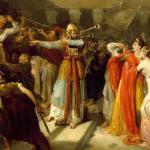Nicholas Thompson ( Eucharistic Sacrifice And Patristic Tradition In The Theology Of Martin Bucer 1534-1546 ) stresses the importance of the second great commandment for Martin Bucer’s Eucharistic reforms:
“love of neighbour necessarily implied the communion of believers with one another and with Christ in the fellowship of the one body. In Grund und Ursach Bucer noted that Paul had called the sacrament Gemeinschafft ; a name that remained among the Greeks [as Synaxis ] and among the Latins as Collect. The antichrists with their sacrifices had seen to it that the memory of this latter title had almost disappeared” (106).
For Bucer, restoring the liturgical rule of love had practical and theological import.
Practically, it meant that the Lord’s service should be a unified event: “Bucer proposed that a single service on Sunday replace the daily Mass, that a single common table replace the multiple altars, and that the people be encouraged not merely to hear the Mass, but to share at the one table. In this common celebration the people would recall their common redemption from sin by the sacrifice of Christ’s body and blood so that they had now had nothing of their own but held everything in common in the fellowship of the one bread and the one body” (106).
Theologically, it led Bucer to emphasize the corporate dimensions of the Eucharist, a theme that came to prominence “in Bucer’s re-appropriation of the language of bodily and substantial presence from the early 1530s” (107).
For the later Bucer, “the communion in the body of Christ was no mere figure of speech but a work of God whereby the Lord dwelt in the faithful naturally and bodily. Augustine, he wrote, meant that Christ imparted his true body and blood offered up on the cross in order that he might be in the faithful and they in him, his limbs and his body . . . .in the 1530s the Lords Supper became for Bucer not merely faithful proclamation of what the church and the faithful had through the sacrificial death of Christ, but the habitual and sacramental means by which the Holy Spirit realised incorporation ( einleybung ) into the body of Christ begun in the sacrament of Baptism, and actualised(albeit imperfectly) in the corporate life of the faithful” (165).
Thompson writes, “For Bucer, the visible corporate life of the church was the arena in which the invisible reality of the mystical body had begun to be actualized visibly . . . . the visible church, its ministry and sacraments were not a priori indispensable for salvation in Bucer’s scheme of things. In the second half of the 1520s sacraments were simply visible signs of invisible grace. However, from the early 1530s, Bucer came to regard them as the habitual and normal instruments by which the Holy Spirit was bringing about the first imperfect manifestations of the kingdom. In this respect, . . . Bucer regarded the visible church as the kingdoms indispensable servant” (283).










